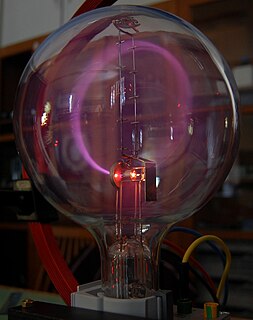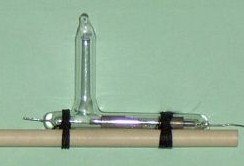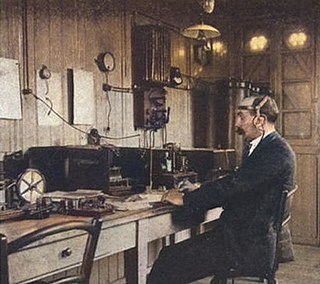
The spark micrometer, also known as a Riess micrometer [1] was a device used by 19th century physicists to measure potential in an electric circuit. It was developed principally by German physicist Peter Riess. It consisted of two electrodes very close together, one of which was attached to a micrometer screw with a calibrated dial, so by turning a knob the width of the gap could be adjusted very precisely. From Paschen's law, the distance between two electrodes when a spark just jumped across a gap was proportional to the potential difference (voltage) between the electrodes, so a spark micrometer could serve as a crude voltage measuring instrument, by widening the gap until the voltage was just able to jump across.
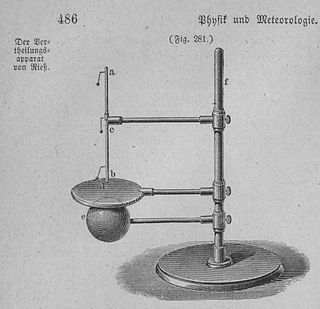
Peter Theophil Riess was a German physicist, known mostly for his work in electricity, particularly friction electricity, but also in the field of electromagnetic induction. In the latter work he developed two devices, the spark micrometer and the Riess spiral coils, both of which were used by Heinrich Hertz in his experiments to prove the propagation of electromagnetic waves.

Paschen's law is an equation that gives the breakdown voltage, that is, the voltage necessary to start a discharge or electric arc, between two electrodes in a gas as a function of pressure and gap length. It is named after Friedrich Paschen who discovered it empirically in 1889.

Voltage, electric potential difference, electric pressure or electric tension is the difference in electric potential between two points. The difference in electric potential between two points in a static electric field is defined as the work needed per unit of charge to move a test charge between the two points. In the International System of Units, the derived unit for voltage is named volt. In SI units, work per unit charge is expressed as joules per coulomb, where 1 volt = 1 joule per 1 coulomb. The official SI definition for volt uses power and current, where 1 volt = 1 watt per 1 ampere. This definition is equivalent to the more commonly used 'joules per coulomb'. Voltage or electric potential difference is denoted symbolically by ∆V, but more often simply as V, for instance in the context of Ohm's or Kirchhoff's circuit laws.
In 1887 Heinrich Hertz found that a spark in a nearby apparatus could induce a spark in a spark gap between the ends of a loop of wire not attached to any source of electricity, discovering radio waves. [2] Hertz used spark micrometers attached to small loop and dipole antennas as receivers in historic experiments to investigate the properties of radio waves. Since the voltage induced in the receiving antenna was proportional to the signal strength of the radio wave, by measuring the length of spark it produced Hertz could measure the field strength of the wave. He showed that radio waves, like light, exhibit refraction, diffraction, interference and standing waves, proving that both radio waves and light are electromagnetic waves. This validated Maxwell's 1873 theory of electromagnetism and his prediction that light consisted of electromagnetic waves. [1]

Heinrich Rudolf Hertz was a German physicist who first conclusively proved the existence of the electromagnetic waves theorized by James Clerk Maxwell's electromagnetic theory of light. The unit of frequency, cycle per second, was named the "Hertz" in his honor.

Radio waves are a type of electromagnetic radiation with wavelengths in the electromagnetic spectrum longer than infrared light. Radio waves have frequencies as high as 300 gigahertz (GHz) to as low as 30 hertz (Hz). At 300 GHz, the corresponding wavelength is 1 mm, and at 30 Hz is 10,000 km. Like all other electromagnetic waves, radio waves travel at the speed of light. They are generated by electric charges undergoing acceleration, such as time varying electric currents. Naturally occurring radio waves are emitted by lightning and astronomical objects.
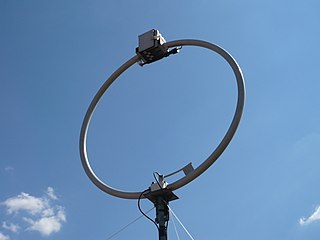
A loop antenna is a radio antenna consisting of a loop or coil of wire, tubing, or other electrical conductor usually fed by a balanced source or feeding a balanced load. Within this physical description there are two distinct antenna types. The large self-resonant loop antenna has a circumference close to one wavelength of the operating frequency and so is resonant at that frequency. This category also includes smaller loops 5% to 30% of a wavelength in circumference, which use a capacitor to make them resonant. These antennas are used for both transmission and reception. In contrast, small loop antennas less than 1% of a wavelength in size are very inefficient radiators, and so are only used for reception. An example is the ferrite (loopstick) antenna used in most AM broadcast radios. Loop antennas have a dipole radiation pattern; they are most sensitive to radio waves in two broad lobes in opposite directions, 180° apart. Due to this directional pattern they are used for radio direction finding (RDF), to locate the position of a transmitter.
